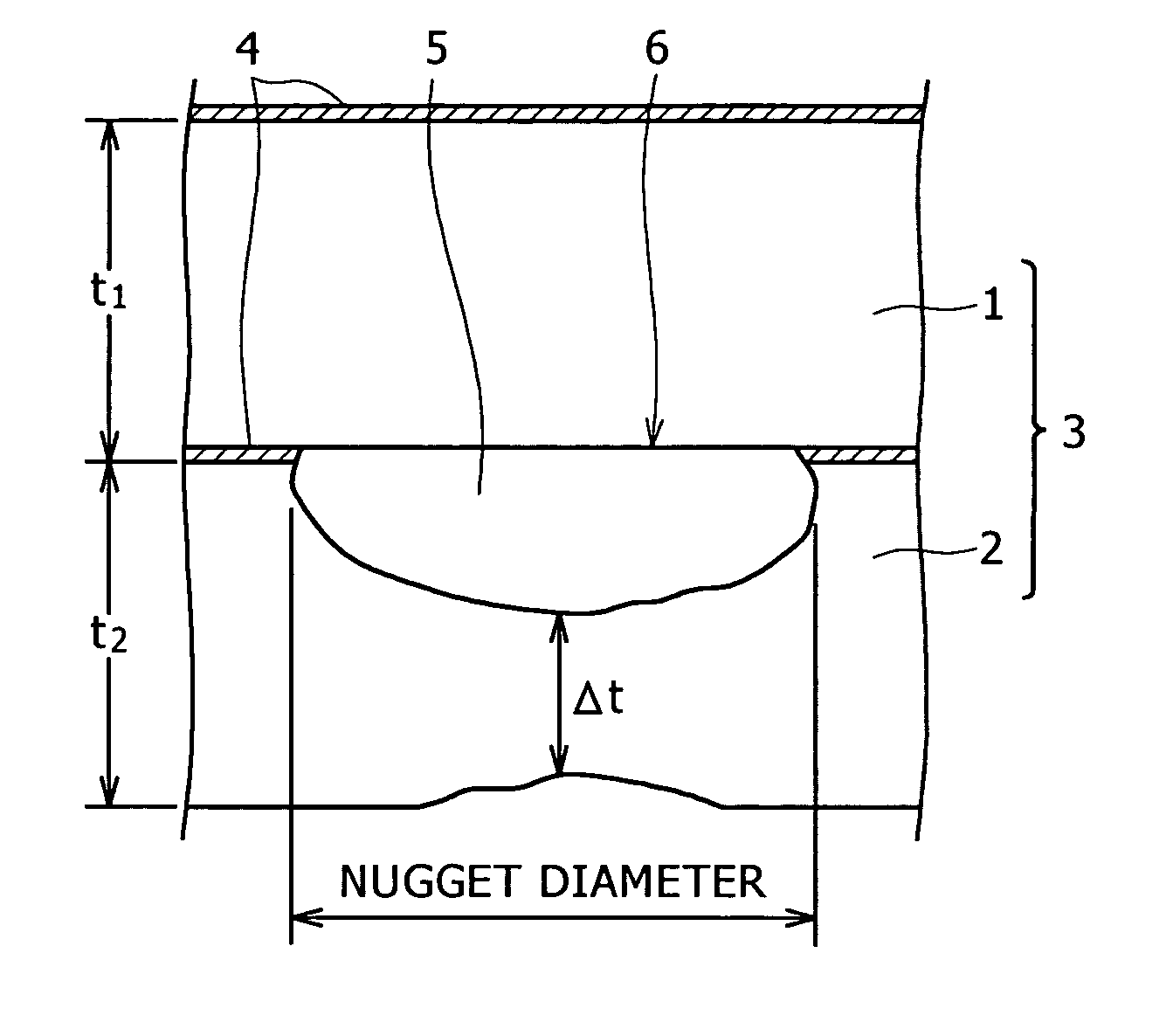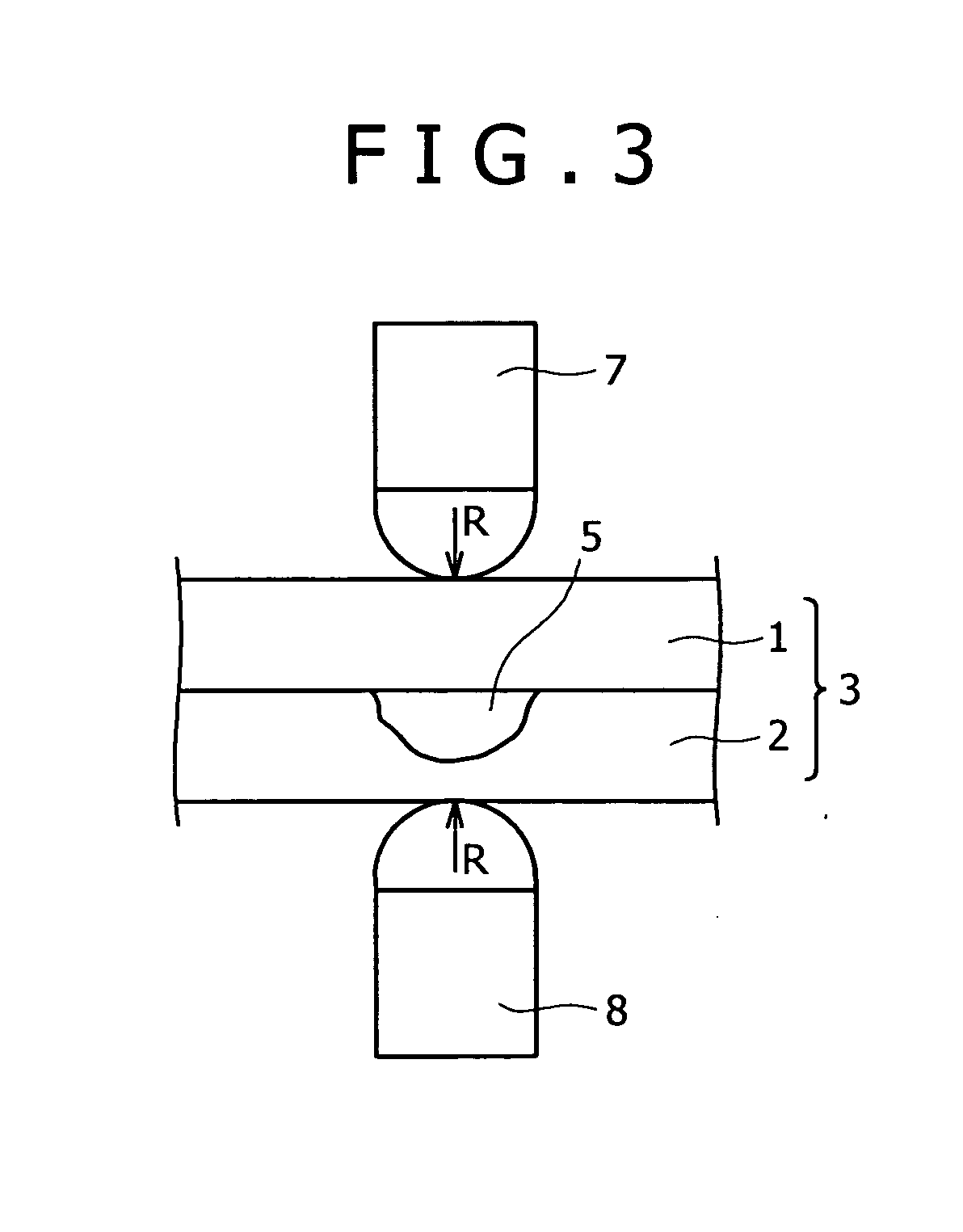Joined Body of Dissimilar Materials Comprising Steel Material and Aluminum Material, and Joining Method Therefor
- Summary
- Abstract
- Description
- Claims
- Application Information
AI Technical Summary
Benefits of technology
Problems solved by technology
Method used
Image
Examples
example 1
[0246] A test steel having a chemical composition (% by mass) shown in Table 1 was melted. A slab of the test steel was rolled to obtain a 1.2 mm thick steel material. The steel material was annealed by a continuous annealing process using temperatures between 500° C. and 1000° C. The annealed steel material was cleaned by water washing or oil washing. The cleaned steel material was tempered to obtain a grade 980 MPa high tensile strength steel material. Commercially available aluminum alloy sheets respectively of 0.1 mm and 1.6 mm in thickness of A6022 (type 6000) were used as test aluminum materials.
[0247] The steel material and the aluminum alloy sheets were cut into pieces of the shape of a cross tensile test specimen and the pieces of the steel material and the aluminum alloy sheets were welded together by spot welding to obtain steel-aluminum welded materials. A dc resistance welding tester was used for spot welding. Welding pressures, welding currents and welding times were ...
example 2
[0258] A test steel having a chemical composition (% by mass) shown in Table 1 was melted. A slab of the test steel was rolled to obtain a 1.2 mm thick steel material. The steel material was annealed by a continuous annealing process using temperatures between 500° C. and 1000° C. The annealed steel material was cleaned by water washing or oil washing. The cleaned steel material was tempered to obtain a grade 980 MPa high tensile strength steel material. Commercially available aluminum alloy sheets respectively of 0.1 mm (Tables 10, 11 and 12) and 1.6 mm (Table 12) in thickness of A6022 (type 6000) were used as test aluminum material. The steel sheets (steel materials) and the aluminum alloy sheets (aluminum materials) were cut into pieces of the shape of a cross tensile test specimen specified in A3137, JIS, and the pieces of the steel material and the aluminum alloy sheets were welded together by spot welding under welding conditions shown in Table 9 to obtain steel-aluminum welde...
example 3
[0268] A test steel having chemical compositions (% by mass) shown in Table 14 was melted. A slab of the test steel was rolled to obtain a 1.2 mm thick steel material. The steel material was annealed by a continuous annealing process using temperatures between 800° C. and 900° C. The annealed steel material was cleaned by water washing or oil washing. The cleaned steel material was tempered to adjust the strength of the steel material to a desired strength. A commercially available 1 mm thick A1050 aluminum alloy sheet containing 0.05% Si and not containing Mn and a commercially available 1 mm thick A6022 aluminum alloy sheet containing 1.10% Si and 0.07% Mn were used as test aluminum materials. The steel sheets (steel materials) and the aluminum alloy sheets (aluminum materials) were cut into pieces of the shape of a cross tensile test specimen specified in A3137, JIS, and the pieces of the steel sheets and the aluminum alloy sheets were welded together by spot welding to obtain st...
PUM
| Property | Measurement | Unit |
|---|---|---|
| Temperature | aaaaa | aaaaa |
| Temperature | aaaaa | aaaaa |
| Length | aaaaa | aaaaa |
Abstract
Description
Claims
Application Information
 Login to View More
Login to View More - R&D
- Intellectual Property
- Life Sciences
- Materials
- Tech Scout
- Unparalleled Data Quality
- Higher Quality Content
- 60% Fewer Hallucinations
Browse by: Latest US Patents, China's latest patents, Technical Efficacy Thesaurus, Application Domain, Technology Topic, Popular Technical Reports.
© 2025 PatSnap. All rights reserved.Legal|Privacy policy|Modern Slavery Act Transparency Statement|Sitemap|About US| Contact US: help@patsnap.com



